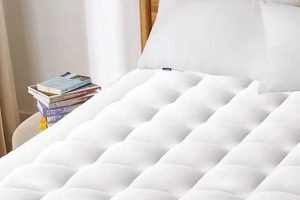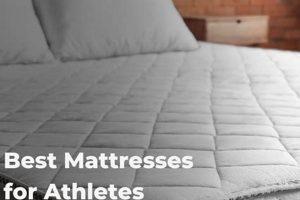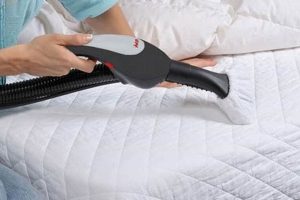The optimal sleep surface for powered bed frames requires specific properties to ensure both comfort and functionality. The selected material must conform to the adjustable frame’s contours without compromising support or durability. A mattress designed for this application will enhance the user’s experience by adapting to various positions offered by the base.
Proper pairing of a sleep surface with an adjustable foundation offers numerous advantages, including enhanced pressure relief, improved spinal alignment, and optimized comfort for activities such as reading or watching television in bed. Historically, traditional innerspring mattresses were not compatible with these frames due to their rigid construction. Modern materials like memory foam and latex have enabled the development of mattresses well-suited to the dynamic nature of adjustable bases.
The following discussion will explore key considerations when selecting a suitable sleep surface for a powered bed frame, including material types, construction methods, and factors affecting longevity and performance. Detailed analysis of these aspects will aid consumers in making an informed purchasing decision.
Selecting a Compatible Sleep Surface
Choosing the right mattress for an adjustable base requires careful evaluation of several factors to maximize comfort and ensure long-term durability. Attention to these details can significantly enhance the performance of the adjustable system.
Tip 1: Material Composition: Memory foam and latex are commonly recommended due to their flexibility and ability to conform to the base’s contours. Innerspring mattresses, particularly those with a high coil count, may not bend effectively and could damage the frame.
Tip 2: Mattress Thickness: Consider the overall height of the mattress in relation to the adjustable base. An excessively thick mattress may limit the degree of articulation, while a very thin mattress may compromise comfort and support.
Tip 3: Edge Support: Reinforce edge support can be beneficial to prevent sagging, particularly if the user frequently sits on the edge of the bed. Enhanced edge support maintains the integrity of the mattress shape when used with an adjustable base.
Tip 4: Motion Isolation: Mattresses with good motion isolation properties are advantageous for couples. This feature minimizes the transfer of movement, ensuring undisturbed sleep when one partner adjusts the bed.
Tip 5: Warranty Coverage: Review the manufacturer’s warranty carefully, paying attention to terms related to use with adjustable bases. Some warranties may be voided if the mattress is not compatible with such a system.
Tip 6: Weight Considerations: Check the weight capacity of both the adjustable base and the mattress. Overloading either component can lead to premature wear or damage.
Tip 7: Flexibility Testing: Before purchasing, if possible, test the mattress on a similar adjustable base to assess its flexibility and conformity. This allows for a practical evaluation of its suitability.
Adhering to these recommendations contributes to an optimal sleep experience by ensuring that the chosen mattress complements the features of the adjustable base and promotes restful sleep.
The subsequent sections will explore specific mattress types and their compatibility with adjustable foundations in greater detail.
1. Flexibility
Flexibility is a critical attribute when determining the most suitable sleep surface for an adjustable base. The functionality of an adjustable bed relies on its ability to articulate into various positions, a capability that directly depends on the mattress’s capacity to conform without compromising structural integrity or comfort. A rigid mattress inhibits the base’s range of motion, potentially damaging the frame and diminishing the intended ergonomic benefits. For example, an innerspring mattress with tightly packed coils may resist bending, creating pressure points and reducing the user’s comfort. In contrast, a mattress composed of memory foam or latex exhibits greater flexibility, allowing it to mold seamlessly to the contours of the adjustable base.
The selection of a flexible mattress also mitigates potential wear and tear on the adjustable frame. Excessive resistance from a rigid mattress can strain the mechanical components of the base, leading to premature failure. Furthermore, the user experience is significantly enhanced. A flexible mattress ensures even weight distribution across the surface, regardless of the base’s position. This reduces pressure points and promotes proper spinal alignment, contributing to a more restful sleep. Consider individuals with medical conditions such as back pain or sleep apnea, who may rely on specific bed positions for relief; a flexible mattress is essential for maintaining the desired therapeutic effect.
In summary, flexibility directly impacts the effectiveness and longevity of an adjustable base system. The degree to which a mattress can conform to the frame’s articulation determines its overall suitability. Selecting a mattress with inherent flexibility properties ensures optimal comfort, support, and durability, maximizing the potential benefits of an adjustable bed. The consequences of neglecting this factor can range from diminished comfort to mechanical failure, underscoring the significance of flexibility in the context of a suitable sleep surface.
2. Material Compatibility
The functionality of an adjustable base is directly contingent on the material composition of the accompanying mattress. Incompatibility between the two results in diminished performance and potential damage to both components. For example, a traditional innerspring mattress, characterized by a rigid coil system, is inherently unsuited for an adjustable base. The restricted movement of the coils prevents the mattress from conforming to the contours of the base, leading to uneven weight distribution, discomfort, and potential bending or breakage of the coils. This incompatibility negates the intended benefits of the adjustable base, such as customized support and pressure relief. Conversely, mattresses constructed from materials such as memory foam or latex exhibit a higher degree of flexibility, enabling them to adapt seamlessly to the adjustable frame’s various positions. This ensures consistent support and comfort across the entire surface of the mattress, regardless of the base’s configuration.
Understanding material compatibility is crucial for optimizing the lifespan and performance of both the mattress and the adjustable base. Utilizing an incompatible mattress can place undue stress on the mechanical components of the base, potentially leading to premature wear and failure. Furthermore, incorrect material selection can compromise the intended therapeutic benefits of the adjustable bed, such a
s alleviating back pain or improving circulation. Consider the practical application of this understanding in healthcare settings, where adjustable beds are frequently used to enhance patient comfort and facilitate medical treatment. The selection of a compatible mattress ensures that patients receive the maximum benefit from the adjustable base, promoting healing and improving overall well-being. For example, a patient recovering from surgery may require specific bed positions to minimize discomfort and promote proper circulation. A mattress that conforms effectively to the adjustable base allows healthcare professionals to customize the bed’s configuration to meet the individual patient’s needs.
In summary, material compatibility is a fundamental consideration when selecting a mattress for an adjustable base. The use of incompatible materials can negate the intended benefits of the adjustable system, compromise comfort, and potentially damage both the mattress and the base. Proper material selection, such as opting for memory foam or latex, ensures optimal performance, longevity, and therapeutic effectiveness. While other factors like thickness and edge support contribute to overall mattress suitability, material compatibility remains a foundational element that dictates the success of the adjustable bed system.
3. Thickness
Mattress thickness plays a significant role in determining the suitability of a sleep surface for an adjustable base. The dimension directly influences the mattress’s ability to conform to the base’s contours, its support characteristics, and its overall impact on the user’s experience.
- Conformability and Articulation
Mattress thickness affects how effectively the mattress bends and conforms to the shapes created by the adjustable base. An excessively thick mattress might resist bending, limiting the base’s range of motion and potentially creating pressure points. Conversely, a very thin mattress may conform easily but lack sufficient cushioning and support, diminishing comfort and potentially impacting spinal alignment. An ideal thickness balances flexibility with support to maximize the benefits of the adjustable base.
- Support and Pressure Relief
Thickness is directly related to the mattress’s capacity for providing adequate support and pressure relief. A thicker mattress generally offers more layers of support materials, such as high-density foam or coils, distributing weight more evenly and reducing pressure on sensitive areas. However, excessive thickness without proper material composition can compromise flexibility, thus hindering the adjustable base’s articulation. Therefore, the selection of the appropriate thickness should consider the user’s weight, sleeping position, and any specific needs for pressure relief.
- Accessibility and Bed Height
The overall height of the mattress, including its thickness, affects ease of getting into and out of bed. A combination of a thick mattress and an adjustable base can result in an excessively high bed, which may be problematic for individuals with mobility issues or those of shorter stature. The height should be carefully considered to ensure accessibility and prevent potential safety concerns. Adjustability of the base can help mitigate this, but the mattress’s thickness remains a primary factor.
- Aesthetics and Bedding Fit
Mattress thickness influences the overall aesthetic appeal of the bed and the fit of bedding. An unusually thick mattress may require deep-pocket sheets, adding to the cost and complexity of bedding selection. The visual proportion of the mattress in relation to the base and surrounding furniture should also be considered, as an excessively thick mattress can appear disproportionate or overwhelm the space.
The interplay between thickness and other factors, such as material composition and density, determines a mattress’s suitability for an adjustable base. The optimal thickness will balance conformability, support, accessibility, and aesthetic considerations, ensuring a comfortable and functional sleeping experience that maximizes the benefits of the adjustable system.
4. Edge Support
Edge support is a critical factor in determining the long-term performance and usability of a mattress when paired with an adjustable base. The perimeter of a mattress experiences concentrated stress, particularly when an individual sits on the edge to get in or out of bed. Without adequate reinforcement, the edges of the mattress can degrade over time, leading to sagging and a reduction in the usable sleep surface. This issue is compounded when the mattress is frequently articulated by an adjustable base, as the bending and flexing can accelerate edge degradation. Mattresses lacking robust edge support may exhibit premature wear along the sides, impacting overall comfort and potentially compromising the alignment of the spine during sleep. Consider, for example, an elderly individual who relies on the adjustable base to elevate their upper body for easier breathing; compromised edge support makes getting into and out of bed difficult, potentially increasing the risk of falls. This undermines the utility of the adjustable base.
The design and construction of edge support vary across different mattress types. Some mattresses incorporate reinforced coils or high-density foam encasements along the perimeter. These features provide additional stability and prevent the edges from collapsing under pressure. The effectiveness of edge support directly influences the overall stability of the mattress when used in conjunction with an adjustable base. When the head or foot of the base is elevated, the edges of the mattress bear a disproportionate amount of weight. If these edges are not adequately supported, the user may experience a sensation of rolling off the bed or instability, which diminishes the comfort and security of the sleep experience. A practical example is a person using their adjustable bed in a semi-upright position to work or read. In this scenario, they are more likely to put pressure on the edges of the mattress, and poor edge support leads to discomfort and a feeling of instability.
In conclusion, edge support significantly impacts the functionality and lifespan of a mattress paired with an adjustable base. Robust edge support minimizes sagging, maintains a consistent sleep surface, and enhances stability, particularly when the base is articulated. Choosing a mattress with reinforced edges ensures long-term comfort and safety, maximizing the benefits of the adjustable bed system. The absence of adequate edge support compromises the usability of the mattress, increases the risk of falls, and accelerates wear, ultimately diminishing the value of both the mattress and the adjustable base. Consequently, assessing edge support is an essential aspect of selecting a suitable mattress for an adjustable frame.
5. Motion Isolation
Motion isolation, or the ability of a mattress to minimize the transfer of movement, is a critical consideration when selecting a sleep surface for an adjustable base. Its importance is magnified in shared bed scenarios, directly impacting sleep quality and overall user satisfaction.
-
Minimizing Partner Disturbance
The primary role of motion isolation is to limit the disruption caused by one sleep partner’s movements to the other. For example, when one individual adjusts the adjustable base to a different position, a mattress with poor motion isolation will transmit that movement across the surface, potentially waking or disturbing the other person. Conversely, a mattress with effective motion isolation absorbs the movement, allowing the other partner to remain undisturbed. This is especially pertinent when one partner is more restless or has a different sleep schedule.
- Material Properties and Construction
The effectiveness of motion isolation is determined by the mattress’s material composition and construction. Memory foam and latex mattresses are generally superior in this regard due to their ability to dampen and absorb movement. Mattresses with individually wrapped coils also offer better motion isolation compared to those with interconnected coils. The density and arrangement of these materials play a crucial role in preventing the transfer of motion across the sleep surface. For instance, a high-density memory foam mattress effectively absorbs movement, while an innerspring mattress with a thin comfort layer transmits it more readily.
- Adjustable Base Functionality
Motion isolation becomes even more relevant when considering the functionality of an adjustable base. The ability to independently adjust each side of the bed is a key feature for many users. However, if the mattress poorly isolates motion, the act of adjusting one side can still disturb the other partner, negating the benefit of independent adjustability. A mattress that effectively minimizes motion transfer ensures that each user can customize their sleep position without impacting the other, maximizing the value of the adjustable base.
- Long-Term Sleep Quality
Over time, poor motion isolation can negatively impact sleep quality, leading to fatigue, irritability, and reduced cognitive function. The cumulative effect of repeated disturbances, even minor ones, can disrupt sleep cycles and prevent individuals from achieving restful sleep. Investing in a mattress with good motion isolation is therefore an investment in long-term sleep health and overall well-being. Choosing an appropriate mattress can help mitigate sleep disruptions, even when using an adjustable base with a partner who moves frequently.
In conclusion, motion isolation is an indispensable feature of any mattress intended for use with an adjustable base, particularly in shared bed configurations. By minimizing partner disturbance, optimizing adjustability, and promoting long-term sleep quality, a mattress with effective motion isolation enhances the overall value and functionality of the adjustable bed system. Selecting a mattress that excels in this area directly contributes to a more restful and undisturbed sleep experience, making it a primary consideration in the purchasing process.
Frequently Asked Questions
This section addresses common inquiries regarding mattress compatibility with adjustable bed frames. Understanding these aspects aids in making informed purchase decisions.
Question 1: Can any mattress be used with an adjustable base?
No. Traditional innerspring mattresses often lack the flexibility required to conform to the adjustable base’s positions. Memory foam, latex, and hybrid mattresses with flexible coil systems are generally more suitable.
Question 2: How does mattress thickness affect compatibility with an adjustable base?
Excessively thick mattresses can limit the base’s range of motion, while very thin mattresses may lack adequate support. A balanced thickness, typically between 10 and 14 inches, is generally recommended.
Question 3: Is edge support important for mattresses used on adjustable bases?
Yes. Reinforced edge support prevents sagging, especially when the head or foot of the base is elevated. This feature enhances stability and maximizes the usable sleep surface.
Question 4: What role does material composition play in adjustable base compatibility?
Materials like memory foam and latex offer the flexibility necessary to conform to the adjustable base’s contours without compromising support. Rigid materials, such as traditional innerspring coils, may hinder articulation.
Question 5: How does motion isolation relate to adjustable base functionality?
Mattresses with good motion isolation prevent disturbances when one sleep partner adjusts the bed, ensuring the other remains undisturbed. This feature is particularly important for couples.
Question 6: Will using an incompatible mattress void the adjustable base warranty?
Possibly. Some manufacturers specify compatible mattress types, and using an incompatible mattress may void the warranty on the adjustable base due to potential strain or damage.
Proper mattress selection is critical for optimizing both comfort and the functionality of the adjustable base. Prioritizing flexibility, appropriate thickness, and adequate edge support ensures a satisfactory sleep experience.
The subsequent discussion will delve into specific mattress brands and models that are well-suited for adjustable bed frames.
The Pursuit of the Best Mattress for Adjustable Base
The preceding discussion explored the multifaceted considerations involved in selecting the best mattress for adjustable base. Emphasis was placed on the critical interplay between mattress material, construction, and compatibility with the adjustable frame’s functionality. Key attributes such as flexibility, thickness, edge support, and motion isolation were identified as pivotal determinants of a successful pairing, directly impacting comfort, longevity, and overall user satisfaction.
Ultimately, the selection of a sleep surface for an adjustable foundation represents a significant investment in both sleep quality and therapeutic benefit. Careful assessment of individual needs, coupled with a thorough understanding of mattress characteristics, is essential to realizing the full potential of the adjustable base system. Continued research and technological advancements in mattress design promise further optimization of this symbiotic relationship, leading to enhanced sleep experiences and improved well-being.






![Top-Rated: Best Mattress for Wall Bed Sleep [Guide] Organic & Natural Mattress Buyer’s Guide: Non-Toxic Sleep Solutions Top-Rated: Best Mattress for Wall Bed Sleep [Guide] | Organic & Natural Mattress Buyer’s Guide: Non-Toxic Sleep Solutions](https://mattressworldpa.com/wp-content/uploads/2025/07/th-7594-300x200.jpg)
![Top: Best Rated Latex Mattress [Reviews & Guide] Organic & Natural Mattress Buyer’s Guide: Non-Toxic Sleep Solutions Top: Best Rated Latex Mattress [Reviews & Guide] | Organic & Natural Mattress Buyer’s Guide: Non-Toxic Sleep Solutions](https://mattressworldpa.com/wp-content/uploads/2025/07/th-7593-300x200.jpg)